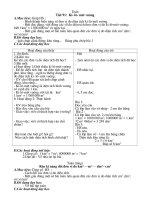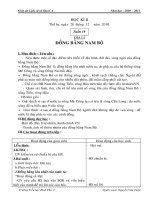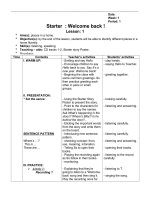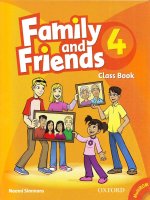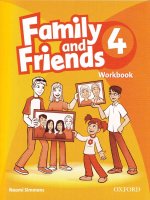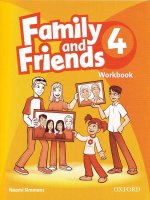Family and Friends 4 tuan 19 23
Bạn đang xem bản rút gọn của tài liệu. Xem và tải ngay bản đầy đủ của tài liệu tại đây (157.26 KB, 26 trang )
Week 19
Monday, January 8 th , 2018
Lesson Four – Period 73
I/ Aims:
- Phonics - CVC words /o/, Speaking and writing skills
II/ Language contents:
1.Structure:
2.Vocabulary: Dog, fox, log
III/ Teaching Aids: CD tracks 51-52, Phonics cards 13- 15
IV/ Steps of teaching:
1.Warm up and reviews:
- Revise the vowel /i/. Ask children to say the chant from page 41 to energize the
class and revise the sound /i/.
2. Presentation:
Listen, point and repeat
- Hold up the dog, fox, and log phonics cards, one at a time, saying the words for
the class to repeat. Elicit to present o.
- Play the first part of the recording for children to listen and point to the pictures.
Play the second part of the recording for children to repeat the sounds and words in
the chorus. Play the recording all the way through for children to point to the
words and then repeat them
3. Practice:
Listen and chant
- Children join in with the chant. Put the three cards around the room and child’s
point as they say the chant. Ask questions about the pictures to establish what
children can see. Then play the recording for them to listen to the chant. Play the
recording again for children to say the chant.
----------------------------------------------------------------------------------------------------
Lesson Four – Period 74
I/ Aims:
- Phonics - CVC words /o/, Speaking and writing skills
II/ Language contents:
1.Structure:
2.Vocabulary: Dog, fox, log
III/ Teaching Aids: CD tracks 51-52, Phonics cards 13- 15
IV/ Steps of teaching:
1.Warm up and reviews:
- Ask the children to join in the chant again. Children then think of some actions
for the count. Play the chant again. Children do their actions as they say the words.
2. Presentation:
Read the chant again.Circle the o in the middle of the words.
- Ask children to look at the chant again. Focus attention on the circled o in the
middle of dog. Ask children to find and circle other examples of o in the middle of
words. Go through the exercise with the class.
3. Practice:
Match the words that rhyme:
- Ask children to look at the pictures. Point to each one for children to say the
word. Make sure they are correctly producing and differentiating the /o/and the /i/
sounds each time. Ask children to draw lines to match four pair of the rhyming
words. Go through the answers with the class.
1 log 2 tin 3 fox 4 big
- Remind children of pairs of the rhythms. Children then write the words that
rhyme. Ask children to work in pairs and compare the answers.
1. Fox/ box 2. Bin/ tin 3. Log/ dog 4. Big. Fig
4. Production:
Phonics game: Play a rhyming game with the class. Read out the pairs of words
below, pausing between them. When children hear two words that match, they clap
their hands:
box/fig, log/dog, bin/box, big/fig, fox/box, log/big, bin/tin
V/ Extension: ........................................................................................................
----------------------------------------------------------------------------------------------------
Thursday, January 11 st , 2018
Lesson Five – Period 75
I/ Aims:
- Describing what animals can or can’t do, Reading skills
II/ Language contents:
1.Structure:
2. Vocabulary: stripes, fruit, nuts, pet, jump, fast, very, beautiful
III/ Teaching Aids: CD tracks 53.
IV/ Steps of teaching:
1.Warm up and reviews:
- Play a game of Jump to revise the words for zoo animals (see page 19)
2. Presentation:
What animals can you see? What colour are they?
- Ask children to look at the pictures of the animals and try to predict what the text
is about (there are two descriptions of animals). Ask Do you like tigers / parrots?
Encourage children to give reasons for their answers. Children ask each other
questions about animals they like and don't like in pairs.
Listen and read
- Play the recording for children to listen and follow silently in their books. Play
the recording a second time. Answer any questions children have. Ask simple
questions to check comprehension, e.g. Has the tiger got stripes? Can it climb
trees? Can the parrot sing / write? Does it like meat / fruit and nuts?
3. Practice:
- Ask children to look at the pictures again. Ask What colour is the tiger / parrot?
Teach the word stripes. Ask Which animal has got stripes? (the tiger). Ask
children to name any other animals they can think of that have (or can have)
stripes, e.g. zebras, cats, birds, and snakes
---------------------------------------------------------------------------------------------------Lesson Five – Period 76
I/ Aims:
- Describing what animals can or can’t do, Reading skills
II/ Language contents:
1.Structure:
2. Vocabulary: stripes, fruit, nuts, pet, jump, fast, very, beautiful
III/ Teaching Aids: CD tracks 53.
IV/ Steps of teaching:
1.Warm up and reviews:
- Memory game: Write the sentences It's a tiger and It's a parrot on the board and
make statements about these two animals. Children listen to the teacher and chorus
It's a tiger if they think the teacher is describing a tiger or It's a parrot if it’s a
parrot. E.g. (Teacher says) It's got stripes. (Children say) It’s a tiger. Here are
more statements: It can talk. (parrot). It's blue, green, red, and yellow. (parrot). It
can run. (tiger). It eats meat. (tiger). It can be a pet. (parrot).
2. Presentation:
- Explain that you are going to do an exercise to see what the animals can do.
Elicit for children to know that they will put ticks when an animal can or can’t do
something in the right columns. Ask children to read the other statements and then
read the text again. They tick the box if the statement is true for that animal. Give
feedback. Ask a different child to read each sentence. The rest of the class say Yes
or No.
3. Practice:
- Children read the description of flamingos and then color the picture. Ask some
comprehension questions, e.g. Can flamingos swim/ fly/stand on one leg?
- Children read the description again and complete the statements. They then work
in pairs and compare the answers.
1bird, 2 pink, 3 eyes, 4 long, 5leg, 6white
4. Production:
Game: Divide the class into groups of four to six. Tell children that they are going
to draw a picture of their favourite zoo animal. Give each child a piece of plain
paper and each group a set of coloured pencils. Children draw their pictures,
sharing coloured pencils with the rest of the group. Children take turns to describe
their animals to the rest of the group. Ask some of the children to show and
describe their animals to the class.
V/ Extension: ......................................................................................................
Week 20
Monday, January 15 th , 2018
Lesson Six – Period 77
I/ Aims:
- Describing what animals can or can’t do, Listening and speaking skills
II/ Language contents:
1.Structure:
2.Vocabulary:
III/ Teaching Aids: CD tracks 54.
IV/ Steps of teaching:
1.Warm up and reviews:
- Ask children to name as many animals as they can. If necessary, help them by
saying I'm thinking of an animal. It lives in a zoo. It's brown / white / little / big,
etc. Write the names of the animals on the board.
2. Presentation:
Listen and number.
- Ask children to talk about the tiger and the parrot from the last lesson.
- Ask children to name the animals on the page 41. Encourage them to describe
the animals and say what they can or can’t do.
- Tell children that they are going to hear a recording of people talking about the
animals in the pictures. They will number the animals in the order they hear them
mentioned. Play the recording through for children to number the pictures. Play the
recording again for them to check their answers.
1 giraffe 2 lion 3 snake 4 chick 5 monkey
3 .Practice:
- Elicit the speech bubbles. Model correct intonation for the class. Ask children to
work in pairs. They take turns to ask and answer similar questions about the
animals in Exercise 1. Give feedback.
-----------------------------------------------------------------------------------------------Lesson Six – Period 78
I/ Aims:
- Describing what animals can or can’t do, Listening and speaking skills
II/ Language contents:
1.Structure:
2.Vocabulary:
III/ Teaching Aids: CD tracks 54.
IV/ Steps of teaching:
1.Warm up and reviews:
- Ask children to sit in groups of 4 -6. One child describes an animal for the others
to guess what it is. E.g. - It’s got four legs. It can run. It’s brown and big. - Is it a
lion? - Yes, it is. Children take turn to describe animals. Ask some of the groups to
talk before the class.
2. Presentation:
- Copy the example onto the board. Elicit the contraction can't = can not. Ask
children to match the sentences with contractions to the ones with full forms.
Allow time for them to finish the exercise. Give feedback.
1b2d3a4c
3. Practice:
- Remind children of the contraction can’t. Ask children to circle the n’t in these
sentences. Go through the answers with the whole class.
- Ask children to read the sentences in exercise 1 carefully and rewrite them in full
form. Check the answers with a partner.
1 A giraffe cannot swim.
2 A monkey cannot fly.
3 A snake cannot run.
4 A dog cannot talk.
- Ask children to read the verbs and circle what they can do and underline what
they can’t do.
- Ask children to draw what they can or can’t do. They then write sentences about
themselves. E.g. I can swim. I can ride a bike. I can’t fly.
Ask children in work in pairs. Talk about themselves.
4. Production:
What’s the animal? Ask four children to come to the front of the class. Give each
child a different zoo flashcard but tell them to keep it hidden. Ask the first child to
describe their animal to the class. Invite questions or guesses from individual
children, until the animal has been identified. Repeat with the other children.
V/ Extension: ........................................................................................................
-------------------------------------------------------------------------------------------------
Thursday, January 18 th , 2018
Period 79: Review
Unit 6: Our new things
Lesson One – Period 80
I/ Aims:
- Identifying classroom objects
II/ Language contents:
1.Structure: Those are.., that is…, this is…
2.Vocabulary: school things: classroom, table, computer, peg, pencil case, board.
III/ Teaching Aids: Verb flashcards 54- 59; Story Poster 6; CD tracks 55- 57;
IV/ Steps of teaching:
1.Warm up and reviews:
- Energize the class by singing the song from Unit 5. Ask children if they
remember Billy, Rosy or Tim.
2. Presentation:
- Use flashcards 54- 59 to elicit the vocabulary for this lesson. Hold them up one at
a time and ask What’s this? Model any words that children don't know Ask
children to point to real objects in the classroom if possible. Hold the flashcards up
in a different order and repeat
3. Practice:
Listen, point and repeat.
- Ask children to look at the pictures of the different school things. Play the first
part of the recording for children to listen and point to the picture. Play the second
part of the recording for children to repeat. Play the recording all the way through
again for children to listen and point and then repeat the words in chorus. Hold up
the flashcards in a random order and ask the class to say the words.
Listen and chant.
- Play the recording for children to listen to the chant. Play the chant a second time
for children to say the words. Repeat if necessary.
4. Production:
Play a memory game with the class. Ask children to close their Class Books and
then ask them to recall the things in Rosy and Tim's new classroom. Write the
words on the board as children name them. Allow children to look at the story in
their Class Books again to see if they remembered everything.
V/ Extension: ........................................................................................................
-------------------------------------------------------------------------------------------------
Week 21
Monday, January 22 nd, 2018
Lesson One – Period 81
I/ Aims:
- Identifying actions
II/ Language contents:
1.Structure: Those are…, that is…, this is…
2.Vocabulary: school things: classroom, table, computer, peg, pencil case, board.
III/ Teaching Aids: Verb flashcards 54- 59; Story Poster 6; CD tracks 55- 57;
IV/ Steps of teaching:
1.Warm up and reviews:
- Play a memory game with the class. Ask children to close their Class Books and
then ask them to recall the things in Rosy and Tim's new classroom. Write the
words on the board as children name them. Allow children to look at the story in
their Class Books again to see if they remembered everything.
2. Presentation:
Listen and read
- Use Story poster 6. Encourage predictions about the story from different
members of the class. Play the recording for them to listen and point to the speech
bubbles in their Class Books. Check comprehension, e.g. What’s in the new
classroom? Do the children like their new things? Has Rosy got a new teddy?
3. Practice:
- Ask children to look at the pictures carefully, identify the things in the pictures,
find and circle the words. Children then work in pairs to compare their works.
1 classroom, 2 table, 3 peg, 4 computer, 5 pencil case, 6 board
- Ask children to look at the pictures from exercise 1 again, identify new school
things and write the words to complete each sentence. Children then sit in pairs,
compare the answers and practice saying the words.
1 classroom, 2 table, 3 peg, 4 computer, 5 pencil case, 6 board
4. Production:
What are there in our classroom? Put children in group of 4- 6. Ask them to
identify and talk about (new) school things in their classroom. E.g. There is a new
white board. There are twenty- four chairs. In 3 minutes, the group which can
identify more school things wins the game. This group will talk before the class.
Other groups listen and can identify any other school things if they can.
V/ Extension: ........................................................................................................
Lesson Two – Period 82
I/ Aims:
- Identifying classroom objects
II/ Language contents:
1.Structure: Those are…, this is…, that is…
2.Vocabulary: Classroom objects;
III/ Teaching Aids: Verb flashcards 54- 59; Story Poster 6; CD tracks 55- 57
IV/ Steps of teaching:
1.Warm up and reviews:
- Play a game of Word chain (see Teacher's Book page 19) using flashcards 54-59,
to energize the class and revise the vocabulary from the previous lesson.
2. Presentation:
Listen to the story again and repeat.Act
- Ask children if they can remember what happened in the story in the previous
lesson. Show Story poster 6 to encourage ideas. Cover the poster and ask children
which school things appeared in the story.
- Ask children to turn to the story on page 43 of their Class Books. Play the
recording, pausing for children to repeat. Divide the class into groups of three to
play the parts of Rosy, Tim, and Miss Jones. Decide on the actions for the story.
Children practise acting out the story. Check children’s work.
Look and say
- Ask children to look at the pictures in the Let's learn! Box. Read the sentences;
elicit to teach the meaning of these/ those/ this and that. Give more examples, e.g.
This is the new classroom. That is a new pencil case. These are new pegs. Those
are new computers. Children repeat the new sentences. Ask them to change the
school words to make new sentences.
3. Practice:
- Ask the class to look at the pictures, identify the school things in each one and
write the missing words. Go through the answers with the class.
1 Those are bags. 2 This is a ruler. 3 These are pencils. 4 That is a computer.
4. Production:
Grammar Reference: Ask children to open their Class Books to p.75 and do the
Unit 6 Grammar activity to practice the target structure further.
V/ Extension: ........................................................................................................
---------------------------------------------------------------------------------------------------
Thursday, January 25 th , 2018
Lesson Two – Period 83
I/ Aims:
- Identifying classroom objects
II/ Language contents:
1.Structure: Those are…, this is…, that is…
2.Vocabulary: Classroom objects;
III/ Teaching Aids: Verb flashcards 54- 59; Story Poster 6; CD tracks 55- 57
IV/ Steps of teaching:
1.Warm up and reviews:
- Put the school things flashcards on the board. Ask children to identify the school
things around the classroom and make sentences about them, using this/ that/
these/ those. Encourage them to make as many sentences as possible in a short
time.
2. Presentation:
Write:
- Revise this/ that/ these/ those. Write some sentences on the board. Read the
sentences again, if possible pointing to real items in your classroom to reinforce
meaning. Indicate some tables that are close to you to demonstrate the meaning of
these, and some further away to demonstrate those, then do the same with
this and that. Children repeat again.
3. Practice:
Point and say
- Ask children to work in pairs. They take turns to make sentences using the
structures these/ those/ this and that with the words in the word pool. Ask children
to talk before the class.
- Ask children to loot at the pictures carefully, identify if the things are close to or
far away and fill in the gaps with This/ That is…. These/ Those are… Ask some
children to write the sentences on the board.
2 Those are pegs. 3 This is a computer. 4. That is a board.
4. Production:
Game: Ask children to sit in group of 4 – 6. Children then to identify school things
around the classroom and make sentences about them, using this/ that/ these/
those. The group which can make more sentences wins the game.
V/ Extension: ........................................................................................................
Lesson Three – Period 84
I/ Aims:
- Identifying classroom objects
II/ Language contents:
1.Structure: I can…
2.Vocabulary: Classroom objects: poster, picture, drawers, cupboard
III/ Teaching Aids: CD tracks 54 - 63, Number flashcards 58- 59
IV/ Steps of teaching:
1.Warm up and reviews:
- Play a game of What's the picture? (see Teacher's Book page 21) to energize the
class and practise the vocabulary that children have learnt so far in the unit
2. Presentation:
- Use flashcards 54-63 to introduce the new vocabulary. Hold up the cards one at a
time and say the words for children to repeat Point to real items in the classroom if
possible. Hold up the cards or point to the items in a different order for children to
repeat again.
3. Practice:
Listen, point and repeat.
- Ask children to look at the pictures in their Class Books. Play the first part of the
recording for children to point to the words. Play the second part of the recording
for children to repeat the words. Play the recording all the way through again for
children to listen and point and then repeat. Hold up flashcards 54-63 one at a time
for individual children to say the words.
4. Production:
Game: Play A long sentence (see Teacher's Book page 21) to revise all the
classroom objects children know. Ask a child What's in the classroom? The child
replies, e.g. A computer. Choose another child and repeat the question. He / She
should repeat the first answer and add another object, e.g. A computer and a board.
Continue until all the objects have been named.
V/ Extension: ........................................................................................................
----------------------------------------------------------------------------------------------------
Week 22
Monday, January 29 th , 2018
Lesson Three – Period 85
I/ Aims:
- Identifying classroom objects
II/ Language contents:
1.Structure: I can…
2.Vocabulary: Classroom objects: poster, picture, drawers, cupboard
III/ Teaching Aids: CD tracks 58 - 59, Number flashcards 54-63.
IV/ Steps of teaching:
1.Warm up and reviews:
- Give flashcards 54- 63 to different children. Play the recording. When a child
hears their word mentioned, they hold their card in the air. Give the cards to
different children and repeat.
2. Presentation:
Listen and sing.
- Use the song worksheet (without opening the Class Book) where children listen
and fill in the correct words. After that ask children to sing along with the CD and
then sing together without the CD audio.
3. Practice:
Sing and do.
-Ask children to look at the pictures and decide together on what the actions should
be. Play the recording for children to listen and do their actions.
- What’s in the classroom? Ask children the question What’s in the classroom?
Encourage them to answer the question with This/ That is…These/ Those are… and
use the school things that the flashcards show.
4. Production:
Word chain: Place flashcards 54- 59 and 60- 63 on the board in one of the given
sequences, e.g. classroom, table, computer, peg, pencil case, board/ poster,
picture, drawers, cupboard. Point to a child. He / She says the first word in the
sequence, i.e. classroom. Point to another child. He or she says the next word in
the sequence, i.e. table. Continue with each child saying the next word in the
sequence, returning to the beginning when necessary.
V/ Extension: ........................................................................................................
------------------------------------------------------------------------------------------------Lesson Four – Period 86
I/ Aims:
- Phonics - CVC words /u/, Speaking and writing skills
II/ Language contents:
1.Structure:
2.Vocabulary: rug, jug, sum
III/ Teaching Aids: CD tracks 60 - 62, Phonics cards 48 - 50
IV/ Steps of teaching:
1.Warm up and reviews:
- Revise the vowel /o/. Ask children to say the chant from page 41 to energize the
class and revise the sound /o/.
2. Presentation:
Listen, point and repeat
- Hold up the rug, jug, and sum phonics cards, one at a time, saying the words for
the class to repeat. Elicit to present u.
- Play the first part of the recording for children to listen and point to the pictures.
Play the second part of the recording for children to repeat the sounds and words in
chorus. Play the recording all the way through for children to point to the words
and then repeat them
3. Practice:
Listen and chant
- Children join in with the chant. Put the three cards around the room and children
point as they say the chant. Ask questions about the pictures to establish what
children can see. Then play the recording for them to listen to the chant. Play the
recording again for children to say the chant.
4. Production:
Phonics activity: Write the words rug, dog, and tin on the board. Ask children to
work in groups and find more words with o, i and u. The group who can find more
words win the game
V/ Extension: ........................................................................................................
----------------------------------------------------------------------------------------------------
Thursday, February 1 st , 2018
Lesson Four – Period 87
I/ Aims:
- Phonics - CVC words /u/, Speaking and writing skills
II/ Language contents:
1.Structure:
2.Vocabulary: rug, jug, sum
III/ Teaching Aids: CD tracks 60 - 62, Phonics cards 48 - 50
IV/ Steps of teaching:
1.Warm up and reviews:
- Ask children to join in the chant again. Children then think of some actions for
the chant. Play the chant again. Children do their actions as they say the words.
2. Presentation:
Read the chant again.Circle the u in the middle of the words.
- Ask children to look at the chant again. Focus attention on the circled u in the
middle of rug. Ask children to find and circle other examples of u in the middle of
words. Go through the exercise with the class.
3. Practice:
Listen to the sound and join the letter:
- Ask children to look at the pictures. Point to each one for children to say the
words (box, tin, rug). Make sure they are correctly producing and differentiating
the /o/, /i/ and the /u/ sounds each time. Ask children to listen to the sounds and
join the letters. Go through the answers with the class.
4. Production:
Phonics game: Play a rhyming game with the class. Read out the pairs of words
below, pausing between them. When children hear two words that match, they clap
their hands:
box/fig, log/dog, mum/ sum, bin/box, big/fig, fox/box, log/big, bin/tin, jug/ rug
V/ Extension: ........................................................................................................
Lesson Five – Period 88
I/ Aims:
- Describing my school, Reading skills
II/ Language contents:
1.Structure:
2. Vocabulary: bright, wall, sit, with, swimming pool
III/ Teaching Aids: CD tracks 63.
IV/ Steps of teaching:
1.Warm up and reviews:
- Energize the class by singing What’s in the classroom? from page 44. Ask
different children to tell you something about their classroom. Encourage as many
comments as possible, e.g. There are posters. There’s a computer.
2. Presentation:
Point to things you can see in a school. Say the words.
- Point to the picture of the boy at the top of the text and explain that his name is
Peter. Ask children to look at the pictures and guess what the text is about (Peter is
describing his school). Encourage children to make predictions about Peter's
school, e.g. There are boys and girls in the class.
- Ask children to look at the pictures again. They point to the different classroom
objects and say the words. If you wish, ask children to work in pairs, taking turns
to point to the classroom objects and say the words. (tables, classroom, chairs,
board, pictures, posters, drawers, windows, book, pupils)
Listen and read
- Tell children that they are going to hear a recording. Play the recording for
children to listen and follow silently in their books. Play the recording a second
time. Ask questions to check comprehension, e.g. What school does Peter go to?
What’s in the classroom? What else is in the school?
